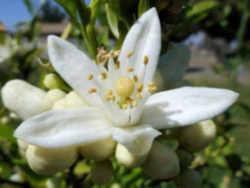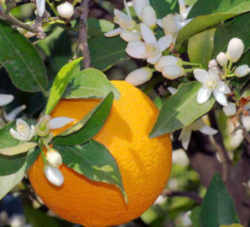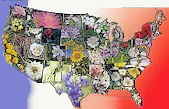
Florida Symbols
Florida State Flower
Orange Blossom

(Citrus sinensis)
Adopted on November 15, 1909.
The orange blossom, (Citrus sinensis,) was adopted as Florida State Flower by Concurrent Resolution November 15, 1909 Legislature. Orange blossoms are one of the most sweet-smelling flowers in Florida. Millions of these white flowers perfume the atmosphere throughout central and south Florida during orange blossom time. Florida also recognizes the orange as official state fruit and orange juice as the state beverage.
Florida State Flower: Orange Blossom

The sweet orange, like most citrus, is native to subtropical Southeast Asia. The Arabians were the first people to mention citrus in their writings, and our word for this fruit is derived from their Sanskirt name. The Moors brought these plants to Spain, where they were used medicinally and in religious services. Although the bitter orange (Citrus aurantium) reached Europe by the 1000s, the sweet orange did not arrive in India until 1330, and was planted in Versailles in 1421. Columbus transported oranges to South America in 1493, and by 1587 Cuba was covered with these beautiful trees. It was the Spanish Missionaries who brought this highly prized fruit to California, establishing the first orange groves in the 1700s.
Characteristics of the Florida Orange
- Leaf: The leaves are shiny and leathery, oblong to elliptic, up to 4" long, and have narrow wings on their petioles (leaf stems).
- Flower: Orange blossoms are white, very fragrant, and arranged in clusters of 1-6. They bloom in spring and give rise to oranges the following autumn or winter. Last year's oranges often are still on the trees when the new flowers are blooming.
- Fruit: A large, round multiple of drupes that is 4 to 5 inches in diameter. The fruit is roundish, golden-yellow or tawny, and several-celled, with a fleshy, juicy pulp; the seeds white and several. The cysts in the rind are convex (L.). The fruit has a very distinctive citrus smell.
- Twig: The twigs on many orange cultivars are thorny.
- Bark: Bark of a greenish-brown color, having axillary spines on the branches.
- Form: The sweet orange is a compact evergreen tree 20-30' tall with a rounded, symmetrical crown spreading 15-20' or so.
Concurrent Resolution of the Florida
The orange blossom was adopted by a Concurrent Resolution of the Florida state legislature on May 5, 1909. The resolution read, in part:
The orange blossom (Citrus sinensis) was adopted by a Concurrent Resolution of the Florida state legislature on May 5, 1909.
The resolution said, in part:
"Whereas, the State of Florida is universally known as the 'Land of Flowers'; therefore,"
Be it Resolved by the House of Representatives, the Senate Concurring:
"That the Orange Blossom be, and the same is hereby chosen and designated as the State Flower in and for the State of Florida."
Taxonomic Hierarchy: Orange
Kingdom: Plantae - Plants
Subkingdom: Tracheobionta - Vascular plants
Superdivision: Spermatophyta - Seed plants
Division: Magnoliophyta - Flowering plants
Class: Magnoliopsida - Dicotyledons
Subclass: Rosidae
Order: Sapindales
Family: Rutaceae - Rue family
Genus: Citrus L. - citrus
Species: Citrus - sweet orange
State Floral Emblems







